Investigation of Mechanical Properties of Recycled Aggregate Concrete Incorporating Basalt Fiber, Copper Slag, and Ground Granulated Blast Furnace Slag
Abstract
1. Introduction
- (1)
- Single/composite admixtures: We first evaluated how single and hybrid incorporation of GGBS and CS (key industrial by-products enhancing the cementitious matrix’s density and pozzolanic reactivity) mitigates RAC’s strength limitations. This phase identified optimal cementitious blends to establish a performance baseline.
- (2)
- Fiber reinforcement: Building on optimal GGBS/CS formulations, we then introduced BF—selected for its high tensile strength and corrosion resistance—to counteract RAC’s brittleness. Multiple BF volume fractions were tested to determine the dosage that maximizes mechanical synergy.
- (3)
- Microstructural validation: EDS and scanning electron microscopy (SEM) analysis directly correlates microscale mechanisms (e.g., interfacial transition zone refinement, pore structure densification, and fiber bridging) with macroscale property improvements, elucidating the triple-composite (CS-GGBS-BF) enhancement mechanism unique to RAC systems.
2. Materials and Experimental Program
2.1. Materials
2.1.1. Aggregate
2.1.2. Binding Material
2.1.3. Basalt Fiber
2.2. Concrete Proportioning
2.3. Pilot Program Design
2.4. Calculation Method
3. Results and Discussion
3.1. Compression Test Results and Analyses
3.1.1. Effect of the Single Mineral Admixture on the Compressive Strength of Recycled Concrete
3.1.2. Effect of Complex Mineral Admixtures on the Compressive Strength of RAC
3.1.3. BF Improves the Compressive Strength of C10-G10 Compound RAC
3.2. Split Tensile Test Results and Analysis
3.2.1. Effect of Single Mineral Admixture on Splitting Tensile Strength of Recycled Concrete
3.2.2. Effect of Complex Mineral Admixtures on the Splitting Tensile Strength of RAC
3.2.3. BF Improves the Splitting Tensile Strength of C10-G10 Compound RAC
3.3. Flexural Test Results and Analysis
3.3.1. Effect of Single Mineral Admixtures on the Flexural Strength of Recycled Concrete
3.3.2. Effect of Complex Mineral Admixtures on the Flexural Strength of RAC
3.3.3. BF Improves the Flexural Strength of C10-G10 Compound RAC
3.4. Workability
4. Microstructure Analysis
4.1. SEM
4.2. EDS
5. Discussion
6. Conclusions
- The ternary system formed by the combined addition of CS, GGBS, and BF significantly enhances the mechanical properties of RAC. When singly doped, the optimal replacement rates for CS and GGBS to maximize RAC’s performance are 10% and 20%, respectively, with GGBS exhibiting a more pronounced strengthening effect (21.3%, 10.2%, and 8.1% improvements in 28-day compressive, splitting tensile, and flexural strengths vs. 18.4%, 2.6%, and 3.7% for CS). When co-doped, CS and GGBS synergistically surpass the single-doping effects, with the 10% CS + 10% GGBS configuration yielding the most substantial enhancements (32.9%, 16.5%, and 16.8% increases vs. RAC; 5.3%, 2.9%, and 1.0% vs. NAC. Building upon this binary system, incorporating 0.2% BF further elevates performance: compared with the baseline RAC, the ternary blend achieves 38.9%, 27.4%, and 24.9% improvements in compressive, splitting tensile, and flexural strengths, respectively, while outperforming NAC by 11.4%, 12.5%, and 8.0%.
- The mechanism by which CS, GGBS, and BF reinforce RAC can be summarized as follows. CS and GGBS form a gradation filling effect with cement particles to enhance concrete compactness; GGBS accelerates early hydration while CS strengthens late-stage hydration, generating C-S-H gels that collectively improve mechanical properties; additionally, BF forms a three-dimensional network to inhibit crack propagation. EDS analysis showed that the Ca/Si ratios of NAC and C10-G10 samples decreased by 36.4% and 28.3%, respectively, compared with RAC, verifying that incorporation of CS and GGBS promoted hydration. SEM results indicated that incorporation of CS and GGBS significantly refined the RAC microstructure: the microstructure density of the C10-G10 and C10-G10-0.2BF samples was higher than that of RAC, with some pores filled by denser C-S-H gels. The EDS analysis showed that the Ca/Si ratios of the NAC and C10-G10 samples decreased by 36.4% and 28.3%, respectively, compared with the RAC. Thus, it was verified that the incorporation of CS and GGBS promoted the hydration reaction. The SEM results showed that the incorporation of CS and GGBS greatly enhanced the microstructure of the RAC samples, and the microstructural density of the C10-G10 and C10-G10-0.2BF samples was increased compared with that of the RAC samples, and some of the pores were filled with C-S-H of higher density.
- Using eco-friendly materials like CS, GGBS, and BF can advance sustainable building practices. Engineers can conduct additional research on how solid waste impacts RAC’s performance.
Author Contributions
Funding
Data Availability Statement
Conflicts of Interest
References
- Chen, Y.; Chen, C.; Cai, Z.; Zhu, P.; Liu, R.; Liu, H. Effect of strength of parent concrete on utilization of recycled aggregate concrete: A review. J. Build. Eng. 2025, 103, 112187. [Google Scholar] [CrossRef]
- Neupane, B.; Sahani, K.; Khadka, S.S. Experimental Testing and Numerical Simulation of Recycled Concrete Aggregate in a Concrete Mix. Int. J. Concr. Struct. M. 2025, 19, 5. [Google Scholar] [CrossRef]
- Konca, P.; Szer, I.; Szer, J.; Obidowski, D.; Gawin, D.; Wiśniewski, P.; Jóźwik, K. Sustainable Infrastructure: Recycled Concrete Aggregates for Cycle Paths. Materials 2024, 18, 131. [Google Scholar] [CrossRef]
- Pepe, M.; Lombardi, R.; Lima, C.; Paolillo, B.; Martinelli, E. Experimental Evidence on the Possible Use of Fine Concrete and Brick Recycled Aggregates for 3D Printed Cement-Based Mixtures. Materials 2025, 18, 583. [Google Scholar] [CrossRef] [PubMed]
- Zhao, D.; Zhang, J.; Liang, H.; Sun, Y. Mechanical properties and constitutive models of rectilinear stirrup confined recycled brick-concrete aggregate concrete. Constr. Build. Mater. 2025, 470, 140532. [Google Scholar] [CrossRef]
- De Brabandere, L.; Grigorjev, V.; Van den Heede, P.; Nachtergaele, H.; Degezelle, K.; De Belie, N. Using Fines from Recycled High-Quality Concrete as a Substitute for Cement. Sustainability 2025, 17, 1506. [Google Scholar] [CrossRef]
- Zhang, W.; Wang, S.; Zhao, P.; Lu, L.; Cheng, X. Effect of the optimized triple mixing method on the ITZ microstructure and performance of recycled aggregate concrete. Constr. Build. Mater. 2019, 203, 601–607. [Google Scholar] [CrossRef]
- Gao, S.; Guo, X.; Ban, S.; Ma, Y.; Yu, Q.; Sui, S. Influence of supplementary cementitious materials on ITZ characteristics of recycled concrete. Constr. Build. Mater. 2023, 363, 129736. [Google Scholar] [CrossRef]
- Wu, J.; Zhang, Y.; Zhu, P.; Feng, J.; Hu, K. Mechanical properties and ITZ microstructure of recycled aggregate concrete using carbonated recycled coarse aggregate. J. Wuhan. Univ. Technol. Sci. Ed. 2018, 33, 648–653. [Google Scholar] [CrossRef]
- Xu, F.; Tian, B.; Xu, G. Influence of the ITZ thickness on the damage performance of recycled concrete. ADV Mater. Sci. Eng. 2021, 2021, 6643956. [Google Scholar] [CrossRef]
- Najimi, M.; Pourkhorshidi, A.R. Properties of concrete containing copper slag waste. Mag. Concr. Res. 2011, 63, 605–615. [Google Scholar] [CrossRef]
- Li, M.; Wang, L.; Chang, S.; Liu, S. Comparative study on preparation and hydration mechanism of composite cementitious materials containing copper slag. Constr. Build. Mater. 2024, 446, 137977. [Google Scholar] [CrossRef]
- Al-Jabri, K.; Shoukry, H. Use of nano-structured waste materials for improving mechanical, physical and structural properties of cement mortar. Constr. Build. Mater. 2014, 73, 636–644. [Google Scholar] [CrossRef]
- Tang, R.; Wei, Q.; Zhang, K.; Jiang, S.; Shen, Z.; Zhang, Y.; Chow, C.W. Preparation and performance analysis of recycled PET fiber reinforced recycled foamed concrete. J. Build. Eng. 2022, 57, 104948. [Google Scholar] [CrossRef]
- Zhang, Q.; Zhang, B.; Feng, Y.; Qi, C.; Chen, Q. Hydration development of blended cement paste with granulated copper slag modified with CaO and Al2O3. J. Mater. Res. Technol. 2022, 18, 909–920. [Google Scholar] [CrossRef]
- Silva, Y.F.; Burbano-Garcia, C.; Araya-Letelier, G.; González, M. Short-and long-term experimental performance of concrete with copper slag: Mechanical and physical properties assessment. Case Stud. Constr. Mat. 2024, 20, e03302. [Google Scholar] [CrossRef]
- Lye, C.Q.; Koh, S.K.; Mangabhai, R.; Dhir, R.K. Use of copper slag and washed copper slag as sand in concrete: A state-of-the-art review. Mag. Concrete Res. 2015, 67, 665–679. [Google Scholar] [CrossRef]
- Panda, S.; Alnounou, M.A.; Jawhara, B.; Sarkar, P. Bond strength and corrosion behavior of rebar embedded in copper slag concrete composites. Constr. Build. Mater. 2024, 416, 135134. [Google Scholar] [CrossRef]
- Sahu, A.; Kumar, S.; Srivastav, A.; Anurag, H. Experimental investigation on the performance of ground granulated blast furnace slag and copper slag blended recycled aggregate concrete exposed to elevated temperatures. J. Build. Eng. 2025, 105, 112531. [Google Scholar] [CrossRef]
- Esfahani, S.M.R.A.; Zareei, S.A.; Madhkhan, M.; Ameri, F.; Rashidiani, J.; Taheri, R.A. Mechanical and gamma-ray shielding properties and environmental benefits of concrete incorporating GGBFS and copper slag. J. Build. Eng. 2021, 33, 101615. [Google Scholar] [CrossRef]
- Wang, Y.; Hu, Y.; Yang, J.; He, Y.; He, X.; Su, Y.; Strnadel, B. Performance of cement-based materials incorporating ultra-fine copper slag. Constr. Build. Mater. 2023, 402, 132949. [Google Scholar] [CrossRef]
- Siddique, R.; Singh, M.; Jain, M. Recycling copper slag in steel fibre concrete for sustainable construction. J. Clean. Prod. 2020, 271, 122559. [Google Scholar] [CrossRef]
- Zhang, D.; Zhu, T.; Yang, Q.; Vandeginste, V.; Li, J. Influence of ground granulated blast furnace slag on recycled concrete powder-based geopolymer cured at ambient temperature: Rheology, mechanical properties, reaction kinetics and air-void characteristics. Constr. Build. Mater. 2024, 438, 137190. [Google Scholar] [CrossRef]
- Ahmad, J.; Martínez-García, R.; Szelag, M.; de-Prado-Gil, J.; Marzouki, R.; Alqurashi, M.; Hussein, E.E. Effects of steel fibers (Sf) and ground granulated blast furnace slag (ggbs) on recycled aggregate concrete. Materials 2021, 14, 7497. [Google Scholar] [CrossRef] [PubMed]
- Guo, Z.; Jiang, T.; Zhang, J.; Kong, X.; Chen, C.; Lehman, D.E. Mechanical and durability properties of sustainable self-compacting concrete with recycled concrete aggregate and fly ash, slag and silica fume. Constr. Build. Mater. 2020, 231, 117115. [Google Scholar] [CrossRef]
- Chen, G.; Li, S.; Zhao, Y.; Xu, Z.; Luo, X.; Gao, J. Hydration and microstructure evolution of a novel low-carbon concrete containing recycled clay brick powder and ground granulated blast furnace slag. Constr. Build. Mater. 2023, 386, 131596. [Google Scholar] [CrossRef]
- Biswal, U.S.; Dinakar, P. Evaluating corrosion resistance of recycled aggregate concrete integrating ground granulated blast furnace slag. Constr. Build. Mater. 2023, 370, 130676. [Google Scholar] [CrossRef]
- Arini, R.N.; Warastuti, N.; Darmawan, M.W.K. Analisis Kuat Tekan dengan Aplikasi Ground Granulated Blast Furnace Slag Sebagai Pengganti Sebagian Semen pada Campuran Beton. Konstruksia 2019, 10, 89–94. [Google Scholar]
- Majhi, R.K.; Nayak, A.N.; Mukharjee, B.B. Characterization of lime activated recycled aggregate concrete with high-volume ground granulated blast furnace slag. Constr. Build. Mater. 2020, 259, 119882. [Google Scholar] [CrossRef]
- Saranya, P.; Nagarajan, P.; Shashikala, A.P. Development of Ground-Granulated Blast-Furnace Slag-Dolomite Geopolymer Concrete. Aci. Mater. J. 2019, 116, 235–243. [Google Scholar]
- Sim, S.; Rhee, J.H.; Oh, J.E.; Kim, G. Enhancing the durability performance of thermally damaged concrete with ground-granulated blast furnace slag and fly ash. Constr. Build. Mater. 2023, 407, 133538. [Google Scholar] [CrossRef]
- Del Bosque, I.S.; Zhu, W.; Howind, T.; Matías, A.; De Rojas, M.S.; Medina, C. Properties of interfacial transition zones (ITZs) in concrete containing recycled mixed aggregate. Cem. Concr. Comp. 2017, 81, 25–34. [Google Scholar] [CrossRef]
- Liu, Q.; Song, P.; Li, L.; Wang, Y.; Wang, X.; Fang, J. The effect of basalt fiber addition on cement concrete: A review focused on basalt fiber shotcrete. Front. Mater. 2022, 9, 1048228. [Google Scholar] [CrossRef]
- John, V.J.; Dharmar, B. Influence of basalt fibers on the mechanical behavior of concrete—A review. Struct. Concr. 2021, 22, 491–502. [Google Scholar] [CrossRef]
- Dong, J.F.; Liu, Y.C.; Xu, Y.; Yuan, S.C.; Wang, Q.Y.; Guan, Z.W.; Chai, H.K. Investigating the structural behaviour of double-skin steel tubes filled with basalt fibre reinforced recycled aggregate concrete under high temperature. J. Build. Eng. 2025, 100, 111782. [Google Scholar] [CrossRef]
- Li, Y.; Zhang, J.; He, Y.; Huang, G.; Li, J.; Niu, Z.; Gao, B. A review on durability of basalt fiber reinforced concrete. Compos. Sci. Technol. 2022, 225, 109519. [Google Scholar] [CrossRef]
- Zheng, Y.; Zhang, Y.; Zhuo, J.; Zhang, Y.; Wan, C. A review of the mechanical properties and durability of basalt fiber-reinforced concrete. Constr. Build. Mater. 2022, 359, 129360. [Google Scholar] [CrossRef]
- Al-Kharabsheh, B.N.; Arbili, M.M.; Majdi, A.; Alogla, S.M.; Hakamy, A.; Ahmad, J.; Deifalla, A.F. Basalt fiber reinforced concrete: A compressive review on durability aspects. Materials 2023, 16, 429. [Google Scholar] [CrossRef]
- Monaldo, E.; Nerilli, F.; Vairo, G. Basalt-based fiber-reinforced materials and structural applications in civil engineering. Compos. Struct. 2019, 214, 246–263. [Google Scholar] [CrossRef]
- Mohamed, O.A.; Al Hawat, W.; Keshawarz, M. Durability and mechanical properties of concrete reinforced with basalt fiber-reinforced polymer (BFRP) bars: Towards sustainable infrastructure. Polymers 2021, 13, 1402. [Google Scholar] [CrossRef]
- GB/T 14685-2022; Pebble and Crushed Stone for Construction. Standards Press of China: Beijing, China, 2022. (In Chinese)
- GB/T 14684-2022; Sand for Construction. Standards Press of China: Beijing, China, 2022. (In Chinese)
- GB175-2023; Standard for General Silicate Cement. Standards Press of China: Beijing, China, 2023. (In Chinese)
- JGJ55-2011; Concrete Proportioning Regulations. Standards Press of China: Beijing, China, 2011. (In Chinese)
- Zheng, Y.; Zhuo, J.; Zhang, Y.; Zhang, P. Mechanical properties and microstructure of nano-SiO2 and basalt-fiber-reinforced recycled aggregate concrete. Nanotechnol. Rev. 2022, 11, 2169–2189. [Google Scholar] [CrossRef]
- GB/T50081-2019; Standard for the Testing of the Physical and Mechanical Properties of Concrete. Standards Press of China: Beijing, China, 2019. (In Chinese)
- GB/T 50080-2016; Standard Test Methods for Properties of Ordinary Concrete Mixes. Standards Press of China: Beijing, China, 2016. (In Chinese)
- Afshoon, I.; Sharifi, Y. Ground copper slag as a supplementary cementing material and its influence on the fresh properties of self-consolidating concrete. J. Struct. Eng. 2014, 7, 229–242. [Google Scholar]
- Sara, B.; Mhamed, A.; Otmane, B.; Karim, E. Elaboration of a Self-Compacting mortar based on concrete demolition waste incorporating blast furnace slag. Constr. Build. Mater. 2023, 366, 130165. [Google Scholar] [CrossRef]
- Singh, J.; Singh, J.; Kaur, M. Copper slag blended cement: An environmental sustainable approach for cement industry in India. Environment 2016, 11, 186. [Google Scholar] [CrossRef]
- Fang, S.E.; Hong, H.S.; Zhang, P.H. Mechanical property tests and strength formulas of basalt fiber reinforced recycled aggregate concrete. Materials 2018, 11, 1851. [Google Scholar] [CrossRef] [PubMed]
- Katkhuda, H.; Shatarat, N. Improving the mechanical properties of recycled concrete aggregate using chopped basalt fibers and acid treatment. Constr. Build. Mater. 2017, 140, 328–335. [Google Scholar] [CrossRef]
- Zheng, Y.; Zhang, P.; Cai, Y.; Moshtagh, E. Cracking resistance and mechanical properties of basalt fibers reinforced cement-stabilized macadam. Compos. Part. B Eng. 2019, 165, 312–334. [Google Scholar] [CrossRef]
- Wang, Y.; Hughes, P.; Niu, H.; Fan, Y. A new method to improve the properties of recycled aggregate concrete: Composite addition of basalt fiber and nano-silica. J. Clean. Prod. 2019, 236, 117602. [Google Scholar] [CrossRef]
- Niaki, M.H.; Fereidoon, A.; Ahangari, M.G. Experimental study on the mechanical and thermal properties of basalt fiber and nanoclay reinforced polymer concrete. Compos. Struct. 2018, 191, 231–238. [Google Scholar] [CrossRef]
- GB 50164-2011; Concrete Quality Control Standards. Standards Press of China: Beijing, China, 2019. (In Chinese)
- Taylor, H.F.W.; Newbury, D.E. An electron microprobe study of a mature cement paste. Cem. Concr. Res. 1984, 14, 565–573. [Google Scholar] [CrossRef]
- Xu, R.; Wang, H.; Yang, R.; Kong, F.; Hong, T. The potential of copper slag as a precursor for partially substituting blast furnace slag to prepare alkali-activated materials. J. Clean. Prod. 2024, 434, 140283. [Google Scholar] [CrossRef]
- Phiri, T.C.; Singh, P.; Nikoloski, A.N. The potential for copper slag waste as a resource for a circular economy: A review–Part I. Miner. Eng. 2022, 180, 107474. [Google Scholar] [CrossRef]
- Gursel, A.P.; Ostertag, C. Life-Cycle Assessment of High-Strength Concrete Mixtures with Copper Slag as Sand Replacement. Adv. Civ. Eng. 2019, 2019, 6815348. [Google Scholar] [CrossRef]
- Seeni, B.S.; Maheswaran, C.; Nakarajan, A. Effect of copper slag addition on the properties of ambient cured alkali-activated pervious concrete. Road Mater. Pavement 2025, 1–26. [Google Scholar] [CrossRef]
- Seeni, B.S.; Madasamy, M.; Maheswaran, C.; Nakarajan, A. Performance of Pervious Concrete with Ground Granulated Blast Furnace Slag (GGBS) as Partial Replacement for Cement. Transp. Dev. Econ. 2025, 11, 4. [Google Scholar] [CrossRef]
- Zhang, B.; Zhang, X.; Wang, M.; Zhang, D.; Wang, D.; Ma, X. Improvement in the Recycled Aggregate Replacement Ratio in Concrete Pavement Bricks by Incorporating Nano-Calcium Carbonate and Basalt Fibre: Model Experiment Investigation. Buildings 2025, 15, 2070. [Google Scholar] [CrossRef]
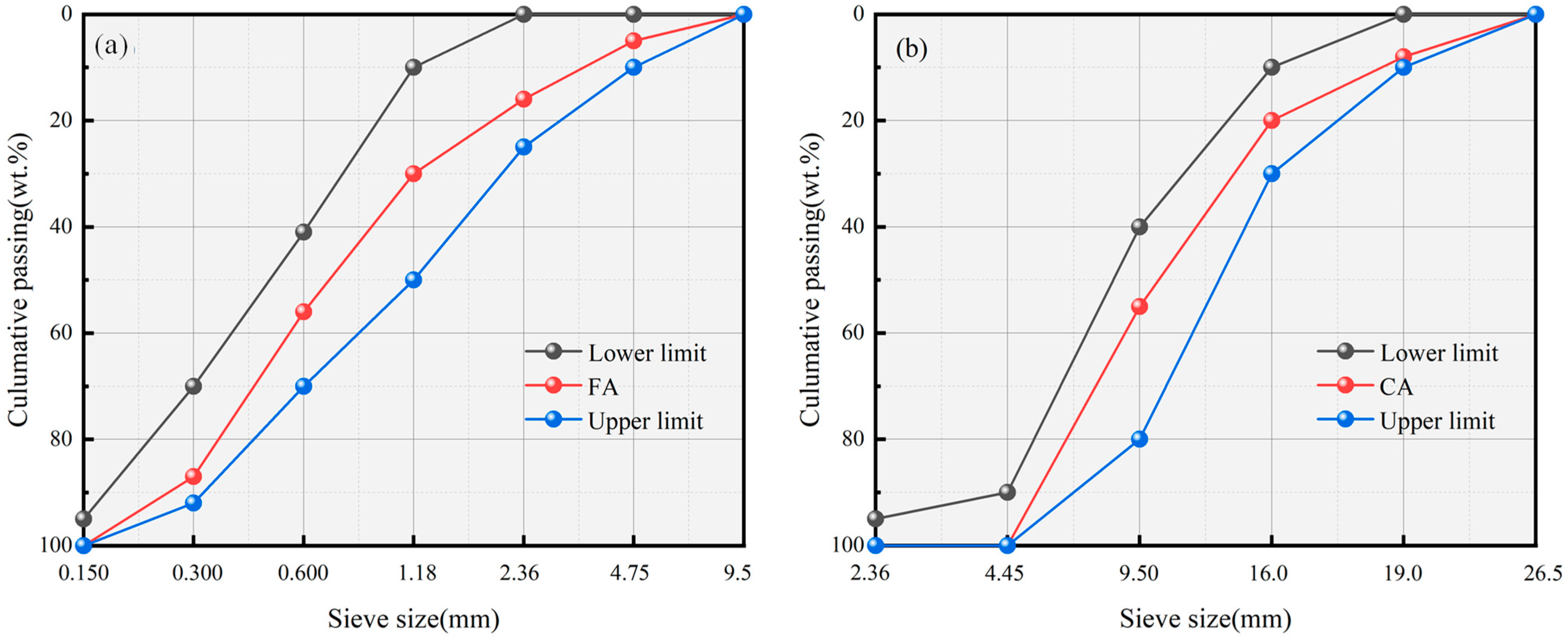

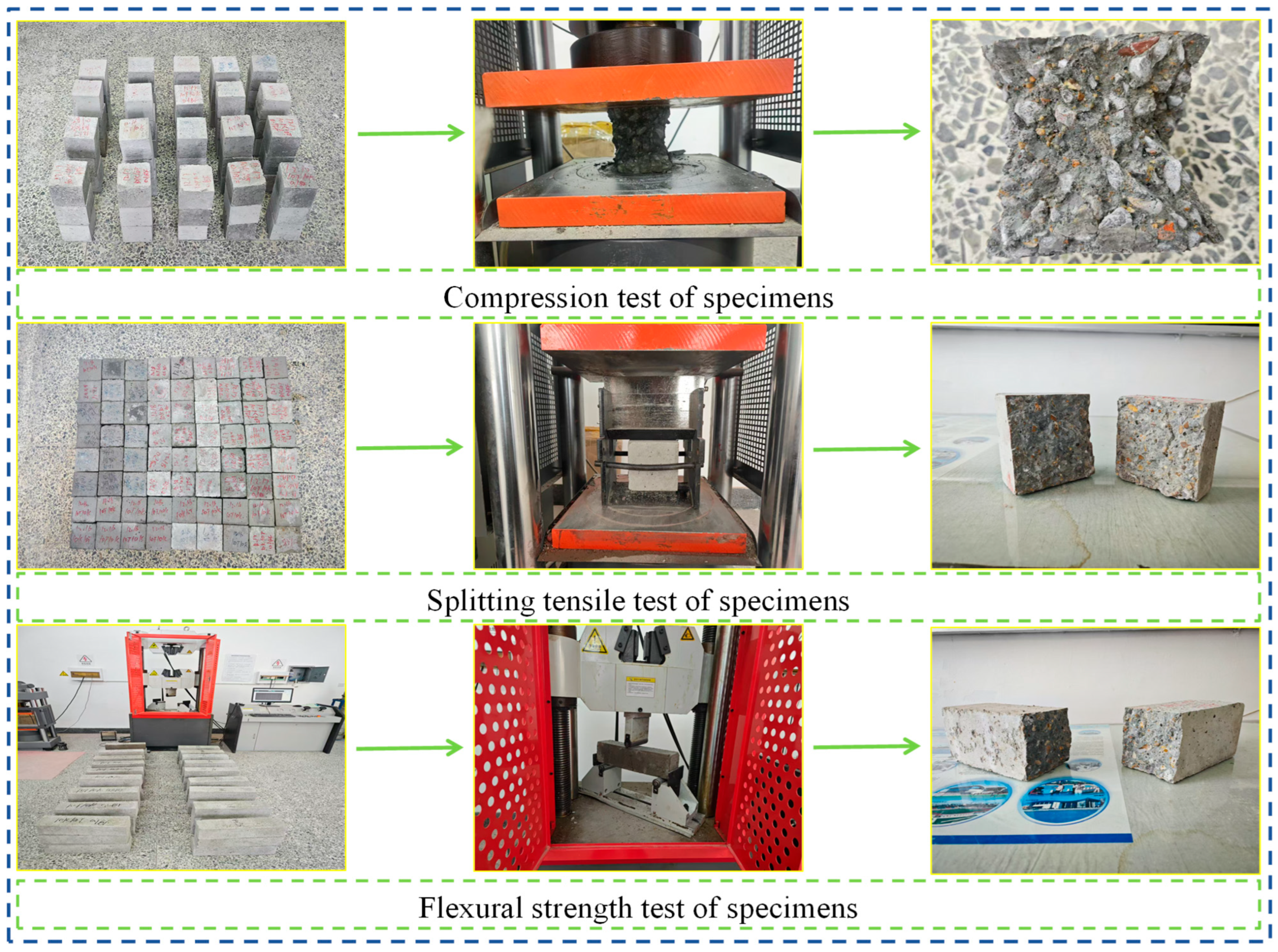

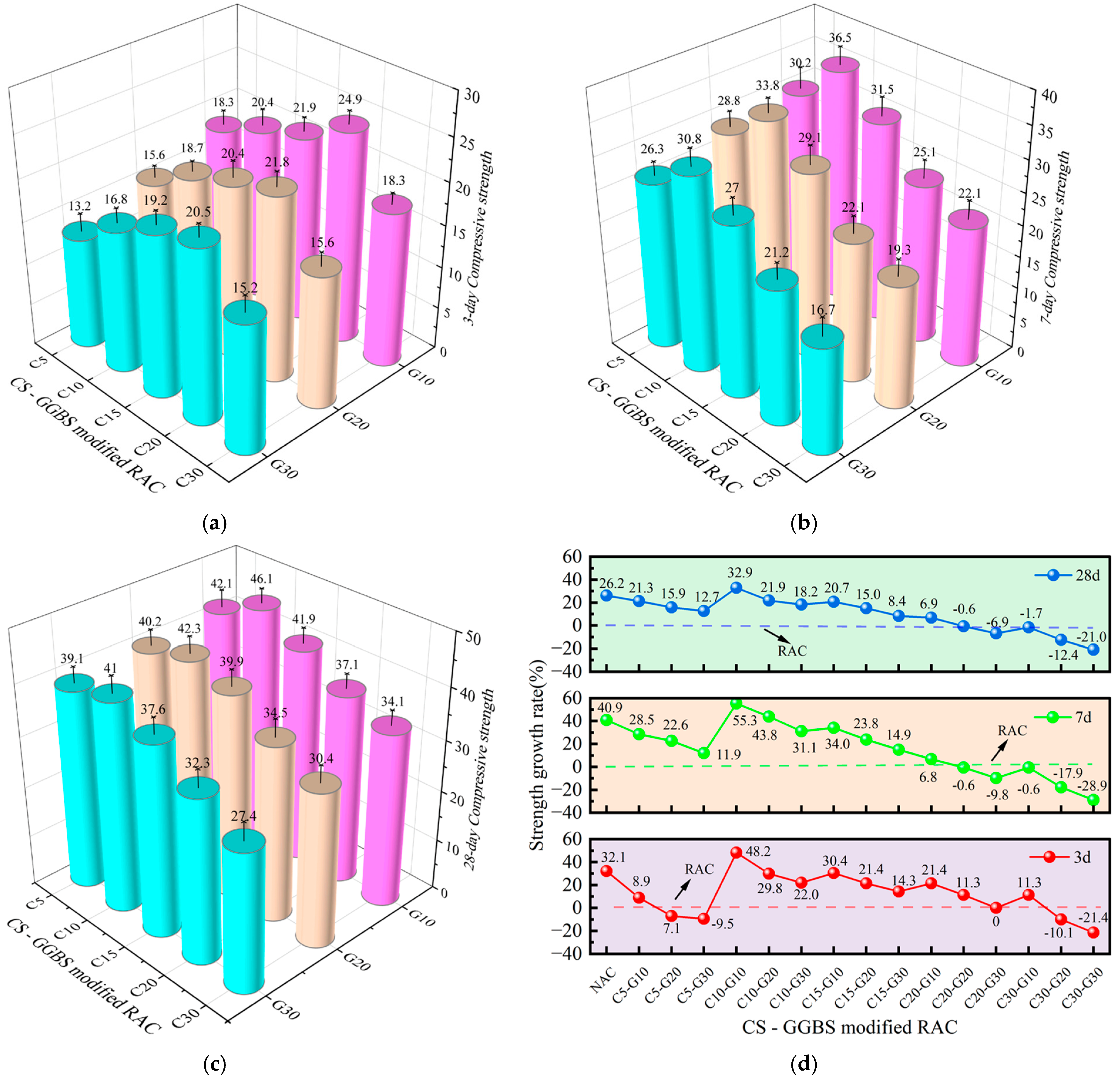
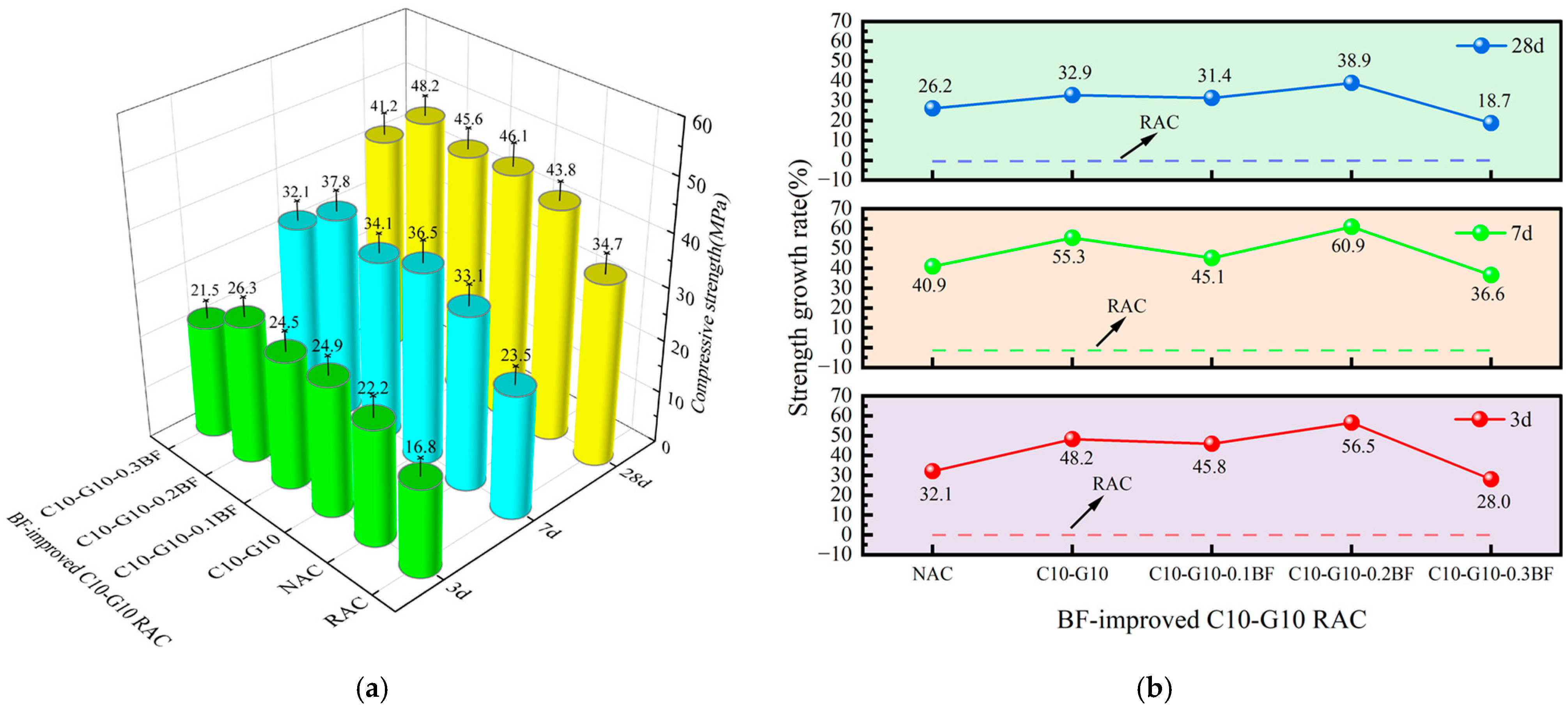

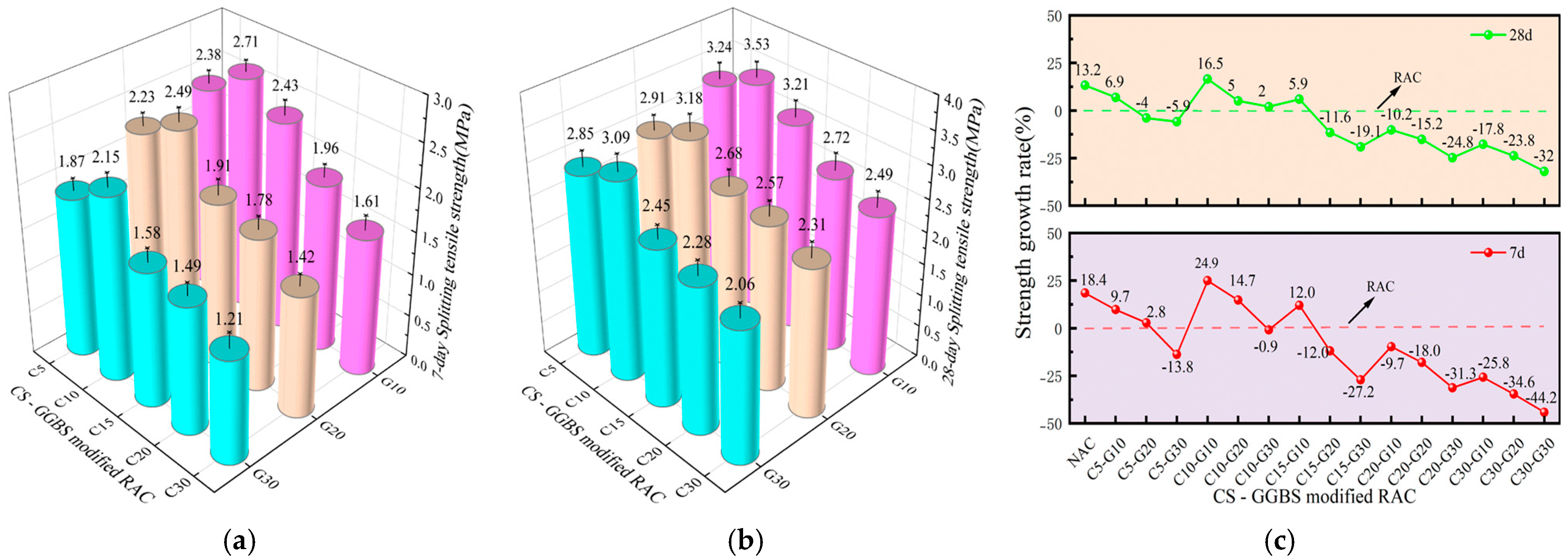
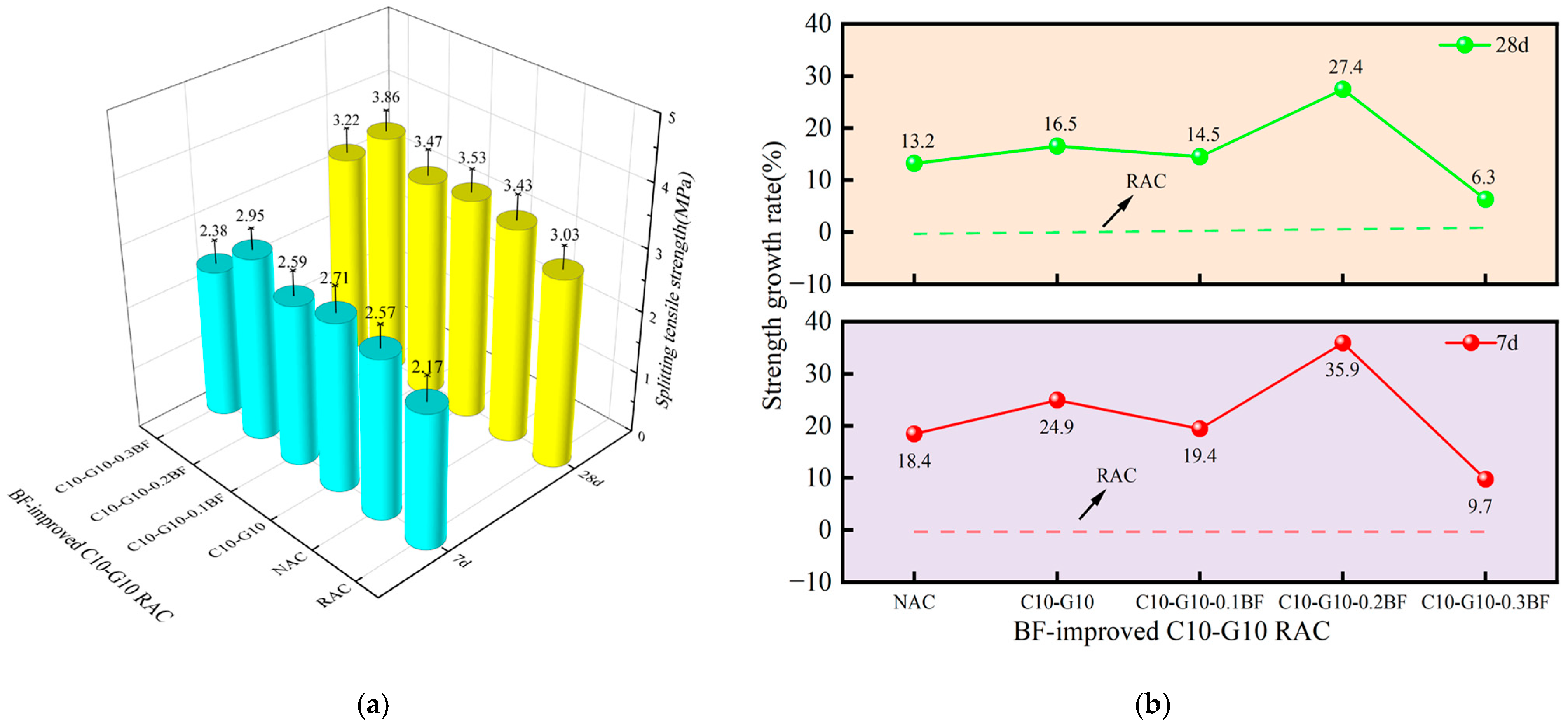
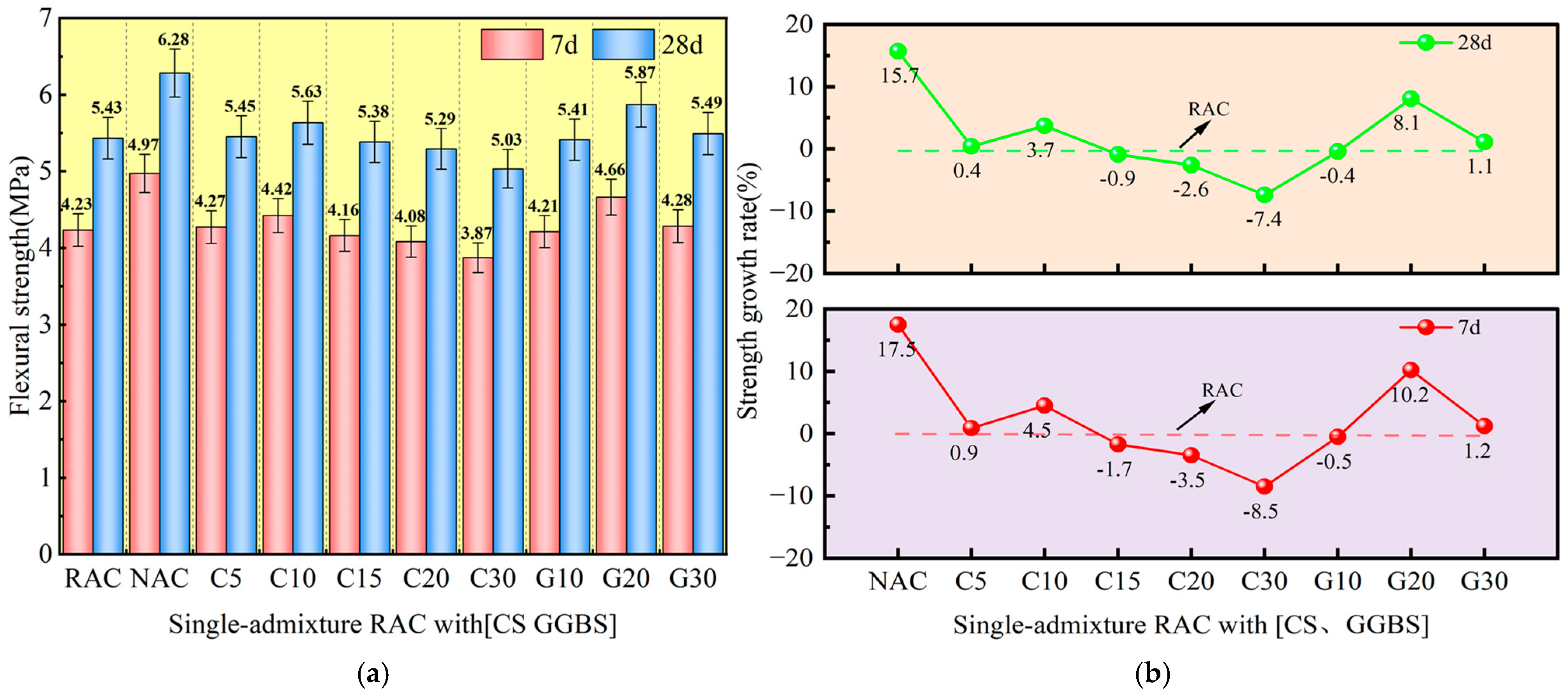
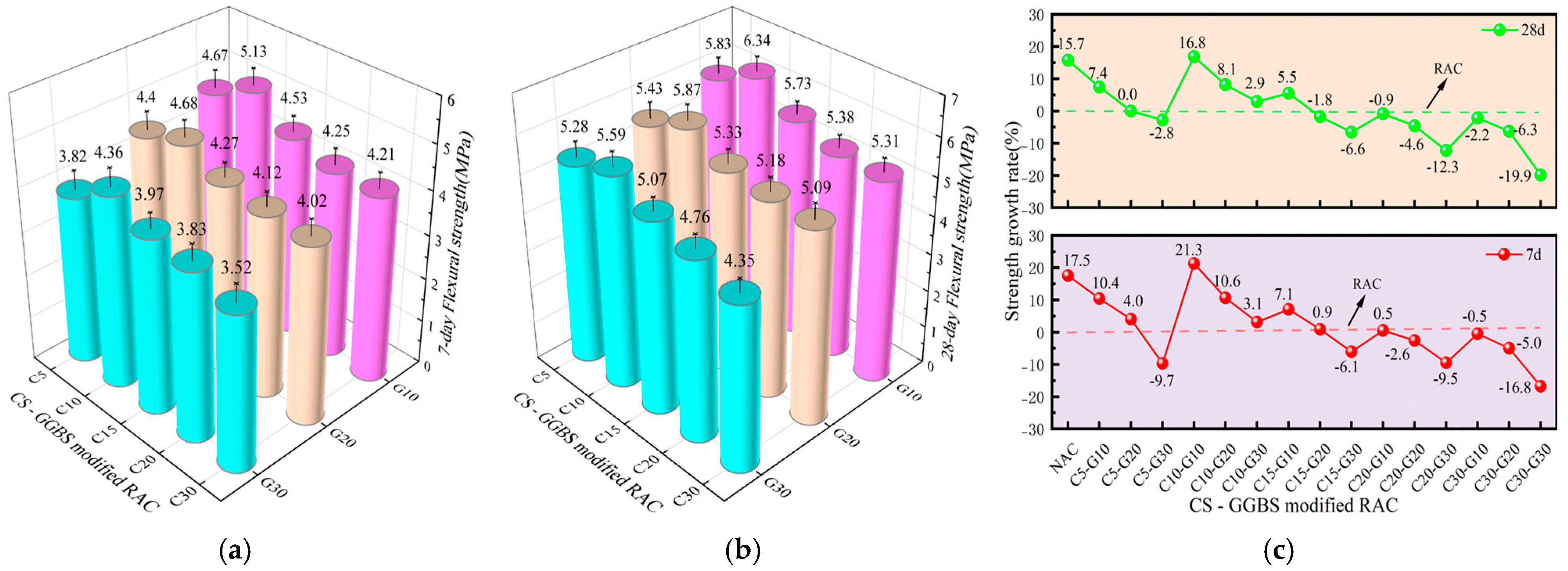
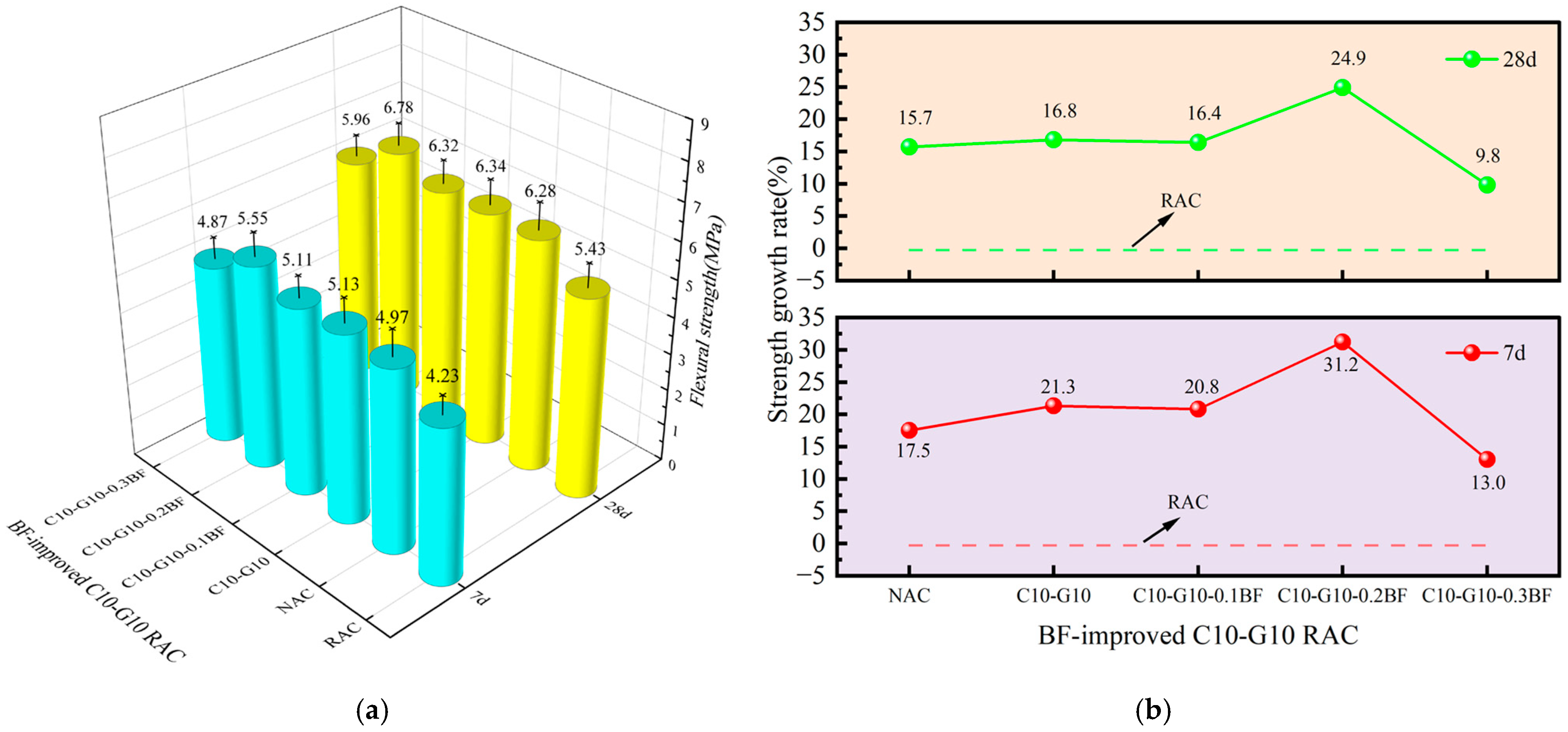

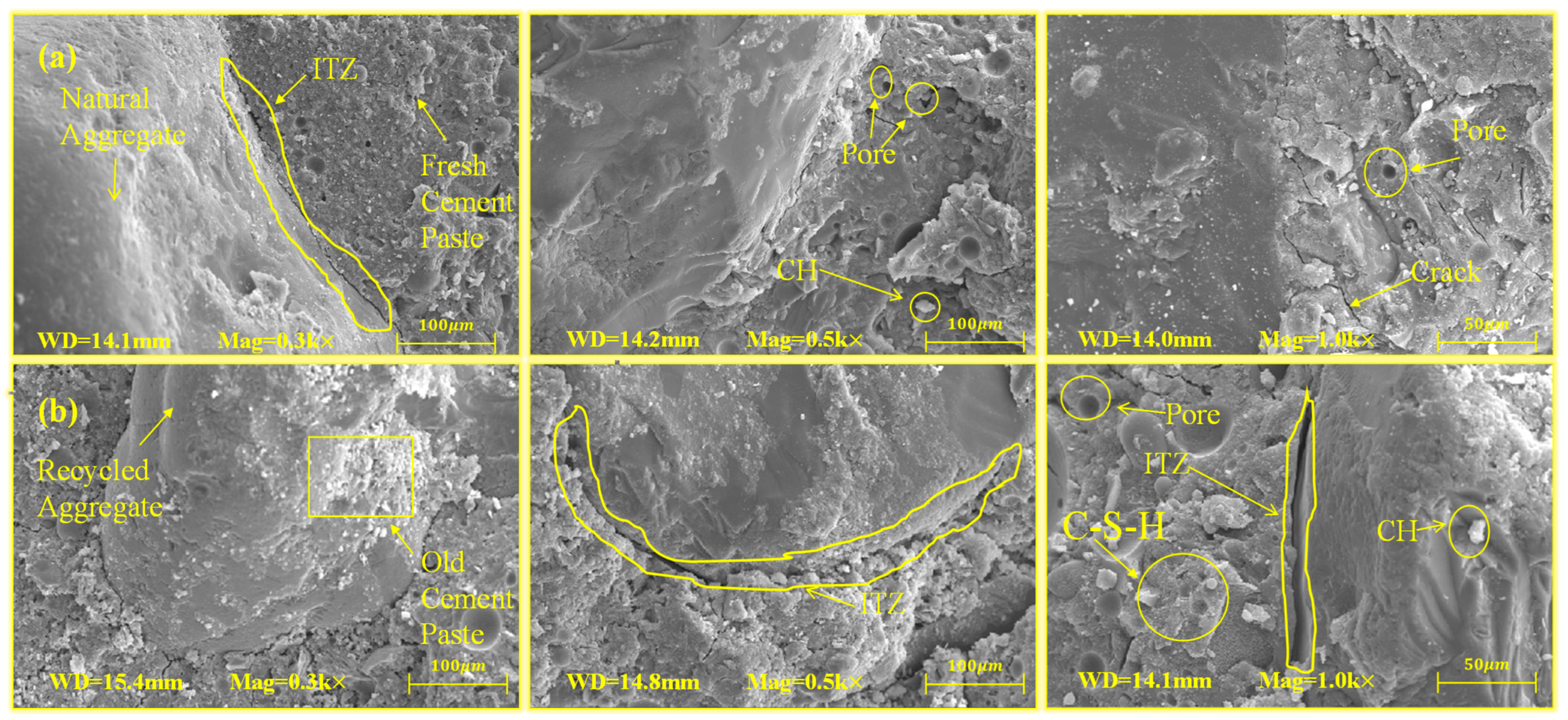
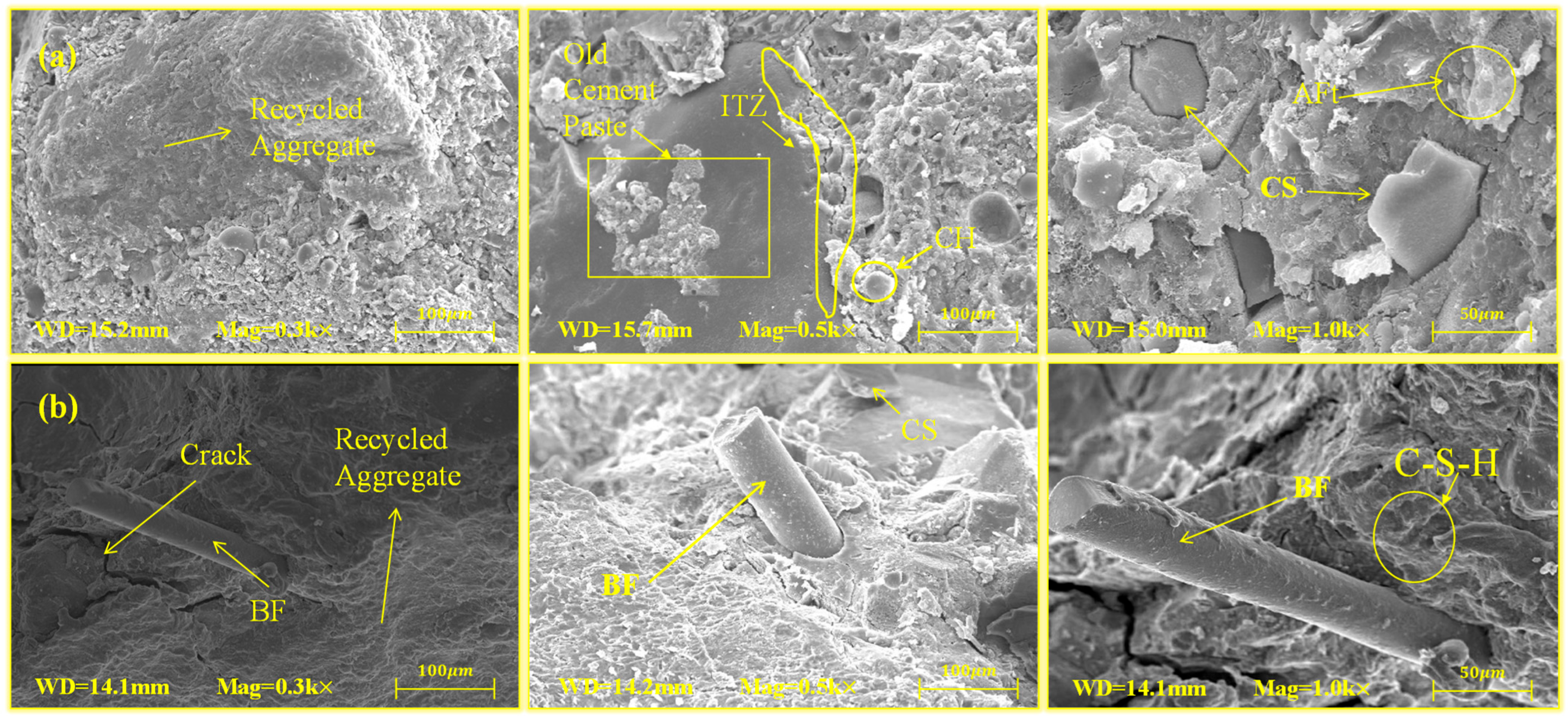
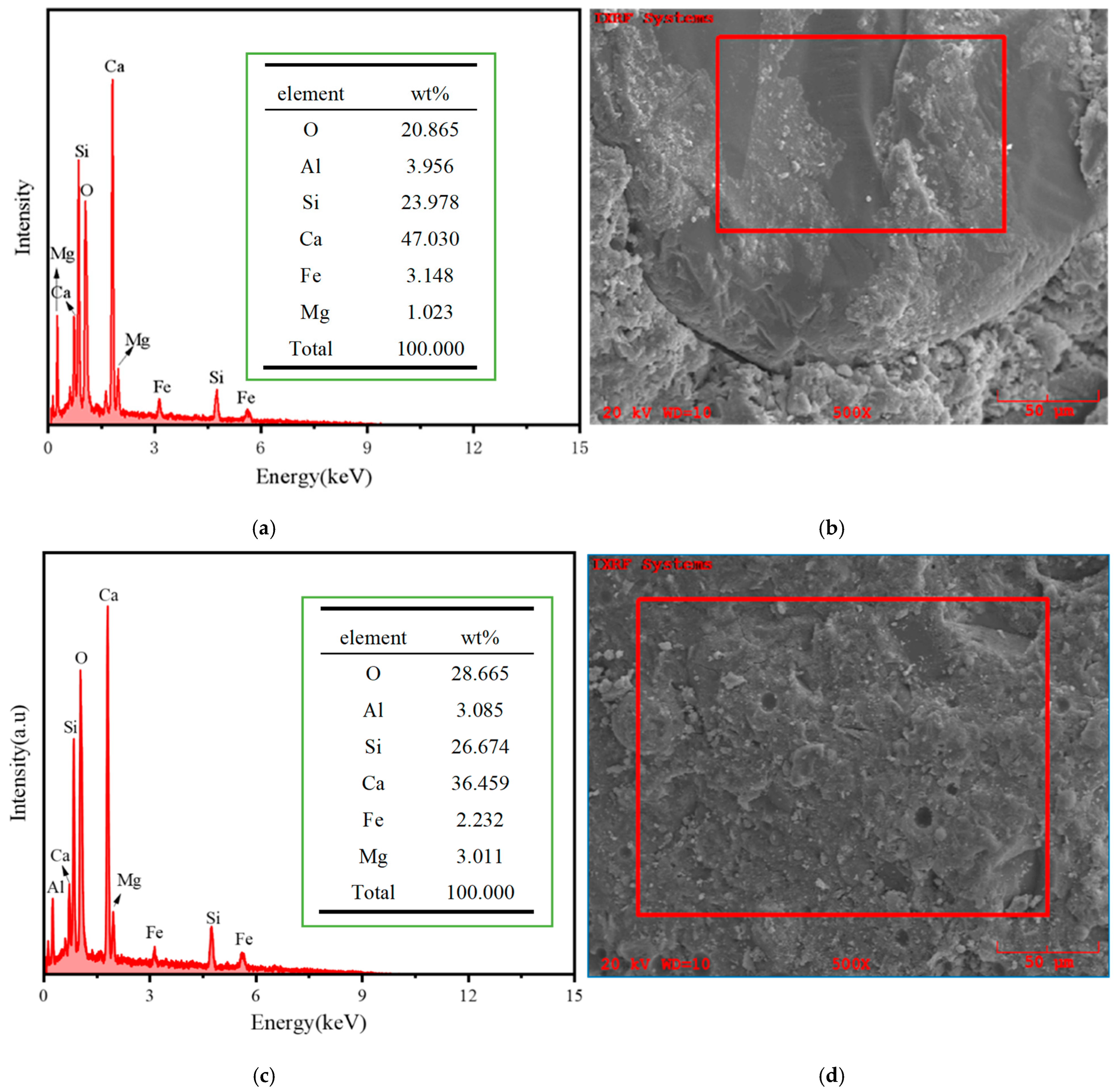
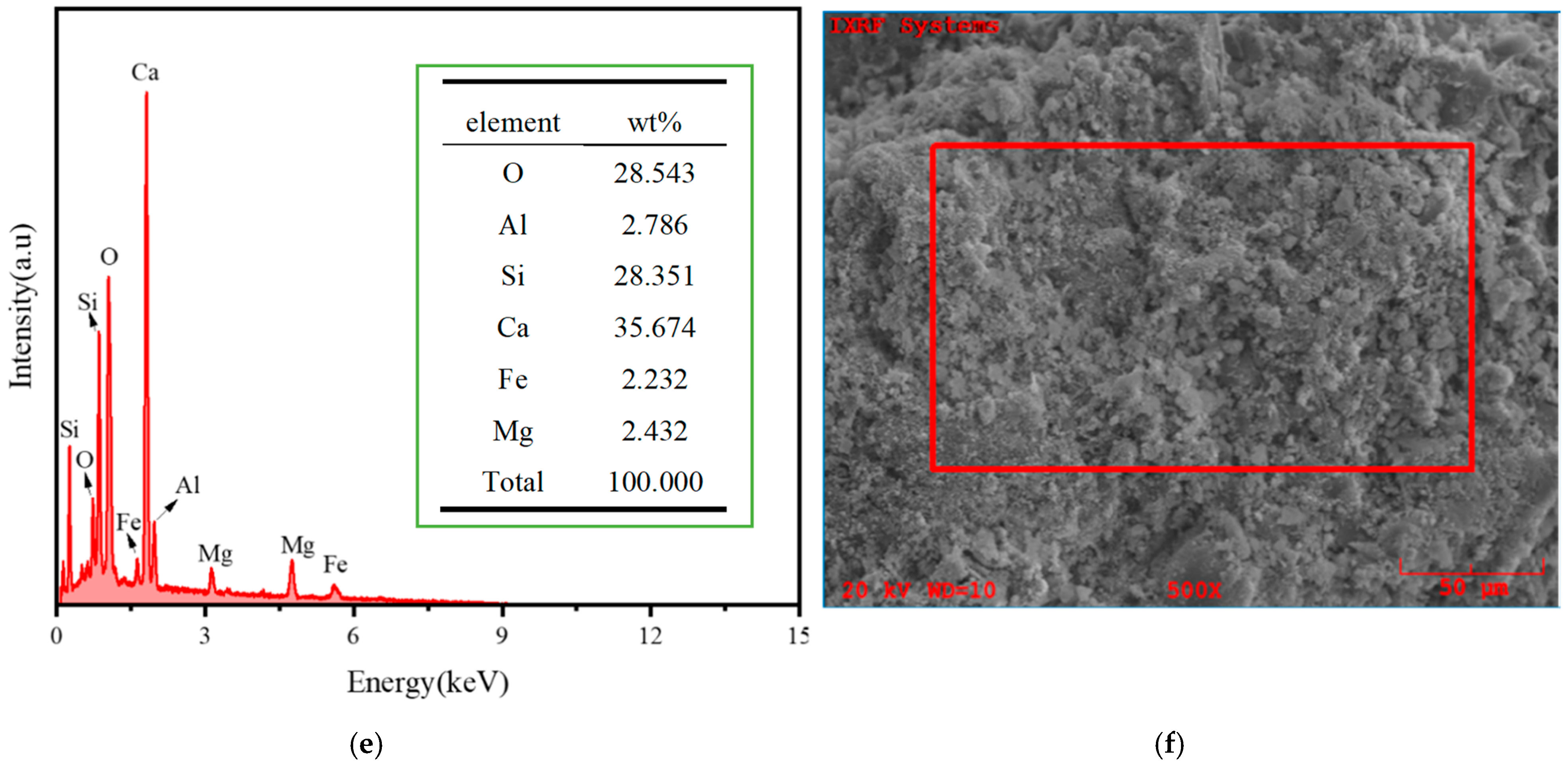

| Coarse Aggregate | Apparent Density (g/cm3) | Packing Density (g/cm3) | Crushing Value | Void Ratio | Moisture Content | Water Absorption |
|---|---|---|---|---|---|---|
| NCA | 2545.43 | 1425 | 17.8% | 47.9% | 1.80% | 0.62% |
| RCA | 2240.38 | 1260 | 23.2% | 50.49% | 1.95% | 4.79% |
| Coarse aggregate | Content of needle and flake particles | Angularity index | Los Angeles abrasion loss rate | Impact toughness (kJ/m2) | Böhme wear value (cm3/50 cm2) | Mass loss rate (rotational wear) |
| NCA | 5.6% | 4.0 | 20.4% | 15.7 | 7.0 | 3.1% |
| RCA | 14.2% | 10.0 | 36.2% | 7.3 | 15.0 | 7.5% |
| Binding Material | SiO2 | Al2O3 | Fe2O3 | CaO | K2O | MgO | Na2O | Mn2O3 | SO3 | CuO | ZnO | TiO2 | Others |
|---|---|---|---|---|---|---|---|---|---|---|---|---|---|
| Cement | 31.60 | 10.95 | 3.85 | 44.23 | 1.19 | - | 0.72 | - | 3.67 | - | - | 0.61 | 3.18 |
| CS | 24.87 | 3.09 | 64.27 | 1.05 | 0.56 | 1.89 | 1.4 | - | 1.45 | 0.04 | - | 1.38 | |
| GGBS | 34.20 | 17.60 | 1.01 | 34.00 | - | 6.21 | - | - | 1.62 | - | - | 5.38 |
| Size (mm) | (wt.%) |
|---|---|
| ≥0.15 | 0.47 |
| 0.074~0.15 | 0.47 |
| 0.045~0.074 | 7.73 |
| 0.03~0.045 | 19.80 |
| ≤0.03 | 71.53 |
| Size (mm) | (wt.%) |
|---|---|
| ≥0.8 | 24.7 |
| 0.045~0.8 | 47.1 |
| ≤0.045 | 28.2 |
| Length (mm) | Breadth (mm) | Relative Density (kg·cm−3) | Tensile Strength (MPa) | Ultimate Tensile Ratio (%) | Alkali-Resistant Strength Retention Rate (%) | Modulus of Elasticity (MPa) |
|---|---|---|---|---|---|---|
| 12 | 1 | 2.62 | 1550 | 3.6 | 35.8 | 35.8 |
| Mixture | Sand (kg/m3) | Cement (kg/m3) | CS (kg/m3) | GGBS (kg/m3) | NCA (kg/m3) | RCA (kg/m3) | Water (kg/m3) | BF (%) |
|---|---|---|---|---|---|---|---|---|
| NAC | 650 | 300 | 0 | 0 | 1000 | 0 | 150 | - |
| RAC | 650 | 300 | 0 | 0 | 700 | 300 | 150 | - |
| C5 | 650 | 285 | 15 | 0 | 700 | 300 | 150 | - |
| C10 | 650 | 270 | 30 | 0 | 700 | 300 | 150 | - |
| C15 | 650 | 255 | 45 | 0 | 700 | 300 | 150 | - |
| C20 | 650 | 240 | 60 | 0 | 700 | 300 | 150 | - |
| C30 | 650 | 210 | 90 | 0 | 700 | 300 | 150 | - |
| G10 | 650 | 270 | 0 | 30 | 700 | 300 | 150 | - |
| G20 | 650 | 240 | 0 | 60 | 700 | 300 | 150 | - |
| G30 | 650 | 210 | 0 | 90 | 700 | 300 | 150 | - |
| C5-G10 | 650 | 255 | 15 | 30 | 700 | 300 | 150 | - |
| C5-G20 | 650 | 225 | 15 | 60 | 700 | 300 | 150 | - |
| C5-G30 | 650 | 195 | 15 | 90 | 700 | 300 | 150 | - |
| C10-G10 | 650 | 240 | 30 | 30 | 700 | 300 | 150 | - |
| C10-G20 | 650 | 210 | 30 | 60 | 700 | 300 | 150 | - |
| C10-G30 | 650 | 180 | 30 | 90 | 700 | 300 | 150 | - |
| C15-G10 | 650 | 225 | 45 | 30 | 700 | 300 | 150 | - |
| C15-G20 | 650 | 195 | 45 | 60 | 700 | 300 | 150 | - |
| C15-G30 | 650 | 165 | 45 | 90 | 700 | 300 | 150 | - |
| C20-G10 | 650 | 210 | 60 | 30 | 700 | 300 | 150 | - |
| C20-G20 | 650 | 180 | 60 | 60 | 700 | 300 | 150 | - |
| C20-G30 | 650 | 150 | 60 | 90 | 700 | 300 | 150 | - |
| C30-G10 | 650 | 180 | 90 | 30 | 700 | 300 | 150 | - |
| C30-G20 | 650 | 150 | 90 | 60 | 700 | 300 | 150 | - |
| C30-G30 | 650 | 120 | 90 | 90 | 700 | 300 | 150 | - |
| C10-G10-0.1BF | 650 | 240 | 30 | 30 | 700 | 300 | 150 | 0.1 |
| C10-G10-0.2BF | 650 | 240 | 30 | 30 | 700 | 300 | 150 | 0.2 |
| C10-G10-0.3BF | 650 | 240 | 30 | 30 | 700 | 300 | 150 | 0.3 |
Disclaimer/Publisher’s Note: The statements, opinions and data contained in all publications are solely those of the individual author(s) and contributor(s) and not of MDPI and/or the editor(s). MDPI and/or the editor(s) disclaim responsibility for any injury to people or property resulting from any ideas, methods, instructions or products referred to in the content. |
© 2025 by the authors. Licensee MDPI, Basel, Switzerland. This article is an open access article distributed under the terms and conditions of the Creative Commons Attribution (CC BY) license (https://creativecommons.org/licenses/by/4.0/).
Share and Cite
Liu, J.; Guo, G.; Wang, X.; Lv, C.; Wang, D.; Geng, H. Investigation of Mechanical Properties of Recycled Aggregate Concrete Incorporating Basalt Fiber, Copper Slag, and Ground Granulated Blast Furnace Slag. Buildings 2025, 15, 2214. https://doi.org/10.3390/buildings15132214
Liu J, Guo G, Wang X, Lv C, Wang D, Geng H. Investigation of Mechanical Properties of Recycled Aggregate Concrete Incorporating Basalt Fiber, Copper Slag, and Ground Granulated Blast Furnace Slag. Buildings. 2025; 15(13):2214. https://doi.org/10.3390/buildings15132214
Chicago/Turabian StyleLiu, Jinglei, Guoliang Guo, Xiangfei Wang, Chun Lv, Dandan Wang, and Hongliang Geng. 2025. "Investigation of Mechanical Properties of Recycled Aggregate Concrete Incorporating Basalt Fiber, Copper Slag, and Ground Granulated Blast Furnace Slag" Buildings 15, no. 13: 2214. https://doi.org/10.3390/buildings15132214
APA StyleLiu, J., Guo, G., Wang, X., Lv, C., Wang, D., & Geng, H. (2025). Investigation of Mechanical Properties of Recycled Aggregate Concrete Incorporating Basalt Fiber, Copper Slag, and Ground Granulated Blast Furnace Slag. Buildings, 15(13), 2214. https://doi.org/10.3390/buildings15132214







